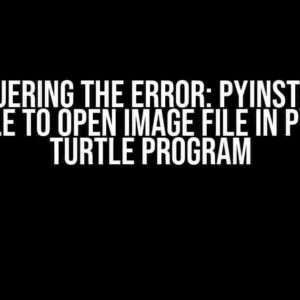Are you tired of cluttered plots with repetitive legends? Do you struggle to merge multiple legends into one cohesive unit? Look no further! In this article, we’ll delve into the world of seaborn’s histplot and explore the secrets of creating a single legend for all subplots without duplicating labels. Buckle up, and let’s dive into the fascinating realm of data visualization!
Understanding the Problem: Duplicate Labels in Seaborn Histplot Legends
Seaborn’s histplot is an excellent tool for visualizing distributions, but it has a notorious weakness: duplicate labels in the legend. When creating multiple subplots, the default behavior is to generate a separate legend for each subplot, resulting in awkward duplicates. This clutters the plot and makes it difficult to read. The question remains: how do we tame this beast and create a unified legend?
The Anatomy of a Seaborn Histplot Legend
Before we tackle the solution, let’s take a closer look at the anatomy of a seaborn histplot legend:
legend_handles: A list of artists (lines, patches, etc.) representing the plotted data.legend_labels: A list of strings corresponding to the labels of each artist.legend_title: An optional string for the title of the legend.
Seaborn’s histplot generates a separate legend for each subplot, which leads to the duplication issue. To create a single legend, we need to merge these individual legends into one.
One approach to unifying legends is by using the legendouters argument in seaborn’s histplot. This argument allows you to specify a custom legend handle for each subplot. By creating a single legend handle and reusing it across subplots, we can eliminate duplicates:
import seaborn as sns
import matplotlib.pyplot as plt
# Create a sample dataset
tips = sns.load_dataset("tips")
# Define the custom legend handle
legend_handle, _ = plt.gca().get_legend_handles_labels()
# Create the histplot with custom legend handle
sns.histplot(data=tips, x="total_bill", hue="sex",
multiple="dodge", legendouters=legend_handle)
# Show the plot
plt.show()
This method works, but it has some limitations. For instance, if your subplots have different numbers of classes or categories, the legend handle may not accurately reflect the correct number of labels.
Solve #2: Merging Legends with matplotlib.patches.Patch
A more robust approach is to create a custom legend by merging the individual legends using matplotlib.patches.Patch. This approach allows for greater control over the legend appearance and can handle varying numbers of classes:
import seaborn as sns
import matplotlib.pyplot as plt
import matplotlib.patches as patches
# Create a sample dataset
tips = sns.load_dataset("tips")
# Define the figure and axes
fig, axes = plt.subplots(1, 2, figsize=(12, 6))
# Create the histplots
sns.histplot(data=tips, x="total_bill", hue="sex", ax=axes[0], multiple="dodge", legend=False)
sns.histplot(data=tips, x="tip", hue="sex", ax=axes[1], multiple="dodge", legend=False)
# Get the legend handles and labels
legend_handles = []
legend_labels = []
for ax in axes:
handles, labels = ax.get_legend_handles_labels()
legend_handles.extend(handles)
legend_labels.extend(labels)
# Remove duplicates and sort labels
unique_labels = sorted(set(legend_labels))
legend_handles = [handles[legend_labels.index(label)] for label in unique_labels]
# Create the custom legend
legend = fig.legend(legend_handles, unique_labels, loc="center right", title="Sex")
# Show the plot
plt.show()
This approach provides a higher degree of customization and flexibility, allowing you to fine-tune the legend appearance to suit your needs.
Solve #3: Using a Single Axes Object with sns.set
A third approach is to use a single axes object and seaborn’s set function to create the histplot. This method eliminates the need for multiple subplots and, consequently, the duplicate legend labels:
import seaborn as sns
import matplotlib.pyplot as plt
# Create a sample dataset
tips = sns.load_dataset("tips")
# Define the figure and axes
fig, ax = plt.subplots(figsize=(6, 6))
# Create the histplot with seaborn's set
sns.set(style="whitegrid")
sns.histplot(data=tips, x="total_bill", hue="sex", ax=ax, multiple="dodge")
# Show the plot
plt.show()
This method is simple and effective, but it may not be suitable for more complex plotting scenarios.
Conclusion: Taming the Beast of Duplicate Legends
In this article, we’ve explored three solutions to the pesky problem of duplicate legends in seaborn’s histplot. By using the legendouters argument, merging legends with matplotlib.patches.Patch, or employing a single axes object with sns.set, you can create a unified legend that enhances the readability and aesthetic appeal of your plots.
Remember, the key to mastering seaborn’s histplot is understanding the underlying mechanics of the legend system. By grasping these concepts, you’ll be well-equipped to tackle even the most complex data visualization challenges.
| Solution | Description | Advantages | Disadvantages |
|---|---|---|---|
legendouters |
Use custom legend handle | Simple, fast | Limited flexibility, may not work with varying class numbers |
Merging legends with matplotlib.patches.Patch |
Merge individual legends | Highly customizable, flexible | More complex, requires manual handling |
Single axes object with sns.set |
Use a single axes object | Simple, easy to implement | Limited to single-plot scenarios, may not be suitable for complex plots |
Now, go forth and conquer the realm of data visualization! May your plots be legend-ary, and your data insights be profound.
Additional Resources
- Seaborn Axis Grids Tutorial
- Matplotlib Legend Guide
- Seaborn Issue #1889: Legend duplication in histplot
Happy plotting, and don’t forget to share your creations with the world!
Frequently Asked Question
Are you tired of dealing with duplicate labels in your seaborn histplot? Worry no more! We’ve got the scoop on how to make one legend for all subplots without duplicating labels.
How do I create a single legend for all subplots in a sns.histplot?
You can use the `legend=False` parameter in your histplot function to remove individual legends for each subplot. Then, use `fig.legend()` to create a single legend for all subplots. Voilà!
What is the purpose of `fig.legend()` in seaborn histplot?
`fig.legend()` creates a single legend that combines all the labels from individual subplots, eliminating duplicates and giving you a neat and tidy legend that represents all your data.
Can I customize the appearance of my single legend in seaborn histplot?
Absolutely! You can customize the appearance of your legend using various parameters such as `loc`, `ncol`, `fontsize`, and more. For example, you can use `fig.legend(loc=’upper right’, ncol=2, fontsize=10)` to place the legend at the top right corner with two columns and font size 10.
How do I remove duplicate labels in my seaborn histplot legend?
By using `fig.legend()`, seaborn automatically removes duplicate labels from the legend. If you still see duplicates, try using `handles` and `labels` parameters to manually specify the legend elements you want to display.
What is the benefit of using a single legend in seaborn histplot?
Using a single legend in seaborn histplot helps to declutter your plot, making it easier to read and understand. It also saves space and reduces visual noise, allowing your audience to focus on the actual data insights.



